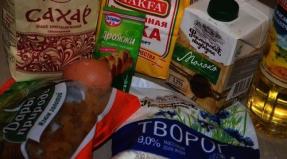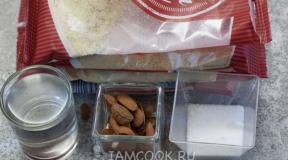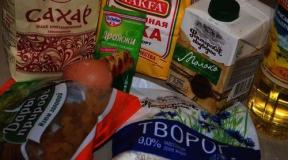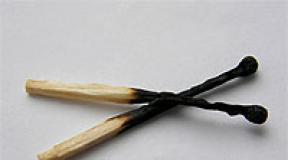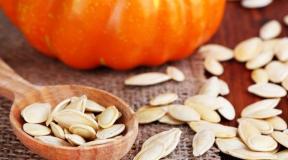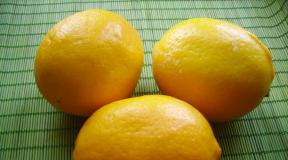Leaf gall aphid. How to deal with leaf gall aphids on currants. Pest life cycles
Hello, please tell me how to cope with red currant disease. We've had it since 2000, but last summer I saw this for the first time. Red pimples appeared on the branches, and red swellings appeared on the leaves. Having examined the leaves, I didn’t find anyone there. What kind of disease is this and what are the causes of its occurrence? How to treat bushes? Help, I beg you. Thank you very much in advance!
Sincerely, your reader Elena Tsvirko, Nesvizh district.
Dear Elena! A leaf gall aphid has settled on your bushes, which mainly affects young leaves of red, white and black currants. Causes the formation of cherry-red galls on the leaves.
The pest overwinters in the egg stage, laid in the fall on the bark of young shoots near the buds. The larvae hatch during bud break. In spring and early summer, a wingless generation appears, and later - winged females, capable of flying over considerable distances. In July, when shoot growth stops, aphids move to wild grasses and weeds, and in September they return to currants to lay eggs.
Control measures
In case of strong development of aphids, during the period of bud break before currant flowering, as well as after harvesting, the bushes should be sprayed with one of the following insecticides: Actellik (15 ml per 10 l of water) or Novaktion (5 ml / 10 l of water).
After flowering, insecticidal solutions of the following phytoncidal plants can also be used to control aphids:
- marigold infusion - place dry crushed plants in an enamel ten-liter bucket (1/2 bucket), add warm water to the brim and leave for 2 days, then strain and add 40 g of laundry soap. Spraying is carried out only until the first signs of ripening of the berries and resumed after harvesting;
- tobacco infusion - take 400-800 g of shag or tobacco dust, pour in 10 liters of water, preferably hot, and infuse for two days. Then strain the infusion through a fine cloth and carefully squeeze out the sediment. Dilute the resulting liquid in 10 liters of water and add 100 g of laundry soap;
- tomato infusion - 4 kg of chopped fresh or 2 kg of dry tops, pour 10 liters of water and boil over low heat for 30 minutes. After cooling, strain the broth. For spraying, for every 10 liters of water, take 2 - 3 liters of decoction and add 40 g of soap. The resulting infusion can also be used to combat ticks, herbivorous bugs, cabbage white caterpillars, moths, codling moth, cabbage cutworm, meadow moth, rapeseed sawfly larvae, cruciferous flea beetles, to repel gooseberry sawfly and moth;
- garlic infusion - finely chop 0.5 kg of garlic cloves, grind, put in a three-liter glass jar, add water at room temperature. Leave to infuse dark place and strain after 5 days. To spray against aphids, it is enough to take 60 g of this garlic infusion and 50 g of soap per 10 liters of water. You can use dry leaves and garlic peels (100 - 150 g), infuse them in 10 liters of water for 24 hours. Use the infusion immediately after preparation;
- infusion of red capsicum - cut 1 kg of raw fruits and pour 10 liters of water, boil for 1 hour in a closed enamel container, leave for 2 days, strain, bottle, store in a cool and dark room. To prepare the working solution, take 125 - 150 ml of concentrate per 10 liters of water and add 30 - 40 g of soap. The resulting solution can also be used to combat suckers, slugs, thrips, and moths.
What are those red spots and swellings that appear on the leaves? How to fight this disease? Red spots were mainly observed on the leaves of red and black currants. But They are also found on apple and pear trees. What to do?
Experienced gardeners are well aware of the reason that causes such leaf changes. This is the red gall aphid (Dysaphis devecta). Unlike ordinary aphids, which are easily visible, red gall aphids are very small. Besides, she's hiding with reverse side leaves. It feeds on the juices of the plant and at the same time injects special substances into it that cause tissue growth - swelling on the leaves.
These bubble folds serve gall aphid refuge from chemicals, with which we are trying to destroy it. During spraying, drops of the solution do not penetrate well into the folds, and the gall aphid is almost not affected.
All types of aphids reproduce quickly and produce several generations over the summer. If no measures are taken, insects greatly weaken the plants by sucking the juices out of them. In addition, aphids stain the leaves with sweet secretions (honeydew). They settle on them sooty fungi and clog the pores on the leaves.
As a rule, the gall aphid is not the only one on the plant. Along with it, numerous colonies of gooseberry aphids feed on the juices. Every year they attack young shoots of currants and gooseberries. Causes curling of leaves and tender tips of shoots.
Control measures
Preventative: thinning bushes and removing thin weak branches.
This technique allows the shoots to grow stronger and better resist pests. First of all, they attack weak plants whose tissues are more delicate.
Carefully inspect plants to identify pests before they have time to multiply heavily and hide under curled leaves.
The use of herbal preparations (mustard, red pepper, tobacco) and biological insecticides during this period. These include Fitoverm, Akarin, Iskra Bio.
Dusting also helps wood ash. Aphids do not like to settle on such plants.
Spraying with chemical insecticides Aktellik, Iskra, Inta-Ts-M, Karate.
When severe defeat aphids, when the tops of the branches are already twisted, it is best to simply cut them off. Burn damaged shoots and leaves.
Do not spare the curled tops of the stems. Good growth they will yield, but on gnarled branches the yield will be very low. The sooner the tops are cut off along with the aphid nests, the faster side shoots will appear on the branches and will have time to ripen well before the end of summer.
You can find this article in the newspaper "Magic Garden" 2011 No. 11.
What is the leaf gall aphid that colonizes red, white and black currant bushes? This is a small insect about 2.2 millimeters long. It refers to sucking representatives. A favorite delicacy is young growing shoots and currant leaves. Pests live in colonies on the underside sheet plate. New growths of dark red, cherry or yellow color in the form of swellings and tubercles, which are called galls.
Life cycle of a pest
Gall aphids overwinter on currants in the egg stage, which the female lays in the fall on the bark of annual shoots next to the buds. With the arrival of spring and the established positive air temperature, when the buds begin to bloom, the larvae hatch. A wingless generation of hungry aphids is born, which needs to eat something. Young, not yet formed currant leaves and green juicy shoots become the main food supply for the pest.
By July, when the growth of currant shoots and leaf blades stops, the gall aphid develops wings and leaves the bushes. The pest migrates mainly to wild and varietal herbaceous plants, where it continues to feed on their juice. Over the summer, more than one or two generations of this pest appear. Surprisingly, aphids, like other insects, are very prolific. By autumn, around September, the pests return to the currant bushes to lay eggs.

Gall aphids pose a particular danger to young currant bushes. Hot weather conditions and availability large quantity pest on garden plot capable of destroying young plants. Damaged leaves and young shoots curl and dry out. On mature shrubs the berries become smaller and plant productivity decreases.
Measures to combat gall midge
The basis of the fight against leaf gall aphids on currant garden plantations is prevention. Here are the main preventive measures:
IMPORTANT: Beneficial insects such as ladybugs and lacewings can destroy a significant number of pests. If you notice that these helpers have appeared on the site, it is better to refrain from using insecticides.

To attract beneficial insects that can significantly reduce the population of gall aphids on currant bushes, it is worth taking care of planting special nectar-bearing plants. It could be marigolds, alyssum. Ladybugs can be attracted by planting asteraceous plants in the garden:
- Tansy;
- Yarrow;
- Daisies.
Many insects beneficial to the garden are attracted to plantings of dill and buckwheat. In addition, using special baits, you can force ladybugs and lacewings to live on personal plot. To do this, you can spray the plants with Wheast, a product sold in garden stores.
In advanced cases, insecticides are used to protect currant bushes from leaf gall aphids. Spraying is carried out in three steps:
- The first is produced at the moment of flowering of the currant, when the buds open;
- The second is after the bushes have faded;
- Third - after the harvest is complete.
Second spraying against aphids experienced gardeners It is recommended to produce with natural insecticidal solutions. Here are some recipes for their preparation:
Tobacco infusion
- Shag or tobacco dust – 400-800 gr.
- Water – 10 liters.
- Laundry soap – 100 gr.
Pour water over the shag or tobacco dust and let it brew for several days. Then the infusion is filtered through cheesecloth and the resulting liquid is diluted with another 10 liters of water with the addition of grated soap.
An infusion of marigolds has proven to be an effective remedy against leaf gall aphids:
- Dry crushed marigolds – 1\2 10 liter bucket
- Water – 10 liters
- Laundry soap – 40 grams
Marigolds are flooded warm water and infuse for 2 days. After which the prepared solution is filtered and grated soap is added. Everything is mixed until the soap is completely dissolved.
And a few more recipes for herbal infusions to combat leaf gall aphids on currants:
Infusion of Red Capsicum
To prepare the concentrate you will need the following ingredients:
- Red hot pepper (raw capsicum) – 1 kg;
- Water – 10 liters;
- Laundry soap – 30-40 grams.
The pepper must be cut and placed in enamel dishes. Then pour cold water and put on fire. After the contents boil, simmer over low heat for about 1 hour. Then let it cool and place in a warm place for several days. Next, filter the resulting concentrate, bottle it, and store it in a cool room.

Plant “fragrant” plants in the area that repel aphids: garlic and marigolds, peppermint and cilantro, fennel and – these aromatic herbs create a natural barrier to aphids. Do not plant crops that are valuable to you under the “favorite” trees of aphids - viburnum, linden and different varieties and plum hybrids.

Aphid control chemicals (chemicals) are also effective in controlling aphids. You can use tools such as:
Types of aphids, names and photographs.
There are approximately 4,000 known species of aphids, and about 1,000 of them are native to the European continent. Some species of aphids are omnivorous and feed on the juices of any plant, but in this family there are also gourmets who prefer a particular type of plant, causing serious harm to it. The most common types of aphids are:
- . The oval body of the insect has a yellow and pale green tint, long antennae are dark brown, and winged females have a pair of transparent wings. The size of individuals does not exceed 3 mm. The pest settles on white, black or red bushes, damaging its leaves, and a large population can completely destroy the plant in a short period of time. Distributed this type aphids are everywhere. The leaf gall aphid sucks out the juices of the plant, which causes the formation of galls - swellings on the leaves of a yellow or burgundy hue.


- . The oval body, slightly expanded on the sides, can have different colors - from green to brown or completely black. The aphid's chest and antennae are black, the abdomen is usually a little lighter, and the entire body is covered with a coating that resembles wax. The pest has dimensions of 3-3.5 mm, affects beet crops and, leguminous plants, poppy, bushes and viburnums, stems and leaves of sunflower. Especially numerous populations of this species are found in Central Asia, in the territory North America, in Transcaucasia. Beet aphids cause the plant to curl and shrivel, its growth slows down, and the plant may die.


- Cucumber or melon aphid . The body of the insect is elongated, pointed towards the rear tip, colored in the most different shades green tone. The size of aphids is from 3 to 4 mm. Antennae and paws are dark brown or black. Aphids strike melons– watermelons, melons, harms pumpkin and cucumber plantings, affects tobacco, peanut and sesame crops, beets, can settle on citrus or eucalyptus leaves. Cucumber aphids are widespread everywhere.


- . The oval and rather wide body of the insect is colored light green, the head has short dark brown antennae, the size of the pest varies from 2 to 4 mm. This type of aphid lives on plants of the cruciferous family, especially preferring crops, radishes and cabbage. Massive and very rapid reproduction of the population quickly leads to the death of plants favored by cabbage aphids. Cabbage aphids are widespread almost everywhere, with the exception of subtropical regions.


- . The insect's body is oval, yellowish or brown in color, with short antennae and a small proboscis. The size of the insect is very small and rarely exceeds 2 mm. This type of aphid lives only on, and completely avoids varieties with pubescent leaf blades or stems. It is found in Africa, some areas of Asia, and causes damage to the vineyards of North America and Europe. Galls appear on the roots, and the leaves of the plant become deformed.


- The body of the insect is oval, painted pale green, the antennae and legs are much lighter than the body, and are short. The size of aphids is 2.5-3 mm. This species harms crops and other plants from the umbrella family, clinging to leaves and stems, thereby reducing the nutrition of the root crop and significantly reducing the yield. Carrot aphids are widespread throughout the world.

- The body of the aphid is oval green, the antennae are brown. This type of aphid settles on both rose hips and. It affects rose bushes, causing the leaves to curl, weakening the plant itself, not tolerating cold well, and reducing the plant's resistance to viral diseases. Lives everywhere.

- has an oval green body, the head is colored reddish or chestnut. Winged females may have a green body and black legs, tail, head and chest. Distributed in East Asia, the Caucasus and Eastern Europe. This type of aphid affects apple trees, pears, cotoneaster, medlar, serviceberry, quince, rowan, and hawthorn.

- The wingless species has a red or green body up to 4 mm long with long antennae and a tail. The body is pointed at the back. The winged species have a light green body and chestnut legs and antennae. Distributed everywhere. It affects potatoes, beets, cabbage, tomatoes, indoor and greenhouse plants.

- has a round body of brownish-gray color up to 5 mm long, short antennae and a black head. The flightless species may also have orange legs and a body covered in black spots. Lives in steppe regions and Crimea. Affects nut and fruit trees, such as peach, almond, cherry plum, plum and apricot. This type of aphid sucks out tree sap and reduces the tree's defenses against fungi and viruses. Fungi cause black, damp spots to appear on the leaves.

- has a yellow-green body with a pink tint. Body length no more than 2.5 mm. Distributed in Europe, Asia, America. It affects plums, peaches, cherry plums, tobacco, cabbage, potatoes, eggplants, peppers, radishes, dill, cucumbers, parsley, lettuce, and greenhouse crops.

- Mealy (hairy) aphid ( mealybug) has an oval cream body with bristles on the sides. The aphids are covered with a snowy white coating. Affects greenhouse and houseplants, grapes and citrus fruits. Because of this type of aphid, the leaves of the plant become powdery, the stems become deformed, the leaves and buds dry out and fall off.


- House aphids can be white, red, green and black in color. Lives everywhere. It affects any plants that gradually wither, dry out and die.

Visually, the presence of gall aphids on currants can be assessed by the swellings and growths that appear on the leaves. The causative agent is the gall leaf aphid, a representative of the many thousands (about 4 thousand species) family of aphids. The insect is very small in size - no more than 2.5 mm in length, with an ovoid body shape. Sexually mature individuals have wings on their backs, while young animals do not have wings. Because of the hairy covering all over their body, gall aphids are often called hairy aphids. The color of the body is from pale yellow to light green.
Damage caused by gall aphids:
- Depletion of shoots - aphids feed on their juices, so the plant switches on a compensation mode - normal leaf tissues are replaced with connective ones - galls - an analogue of human scars. If you do not take measures to destroy aphids, they will continuously multiply and live on the bush until they have a source of food and the plant dies from exhaustion;
- Leaf aphids are often an intermediate host for viral diseases plants;
- Aphids and ants are a zoologically interesting symbiosis. Ants use leaf aphids as livestock- they graze it, protect the young, protect the “herd” from entomophages and even milk it - they rub their paws against the aphids to get the milk produced by the bodies of the pests. Entomophages are insects that eat aphids - lacewings, hoverflies, ladybugs- however, if the herd is guarded by ants, it is not possible to get to the aphids.
The shoots on which the aphid has already “worked”, even after its complete elimination, remain atrophied - there is a lag in growth, practically cannot be regenerated, the yield is reduced or absent.
Who's who in aphids?
Aphids are polymorphic insects. That is, in one colony there are individuals of different age and purpose. Highlight:
- The queen aphid is a viviparous individual that reproduces all generations that appear in one season. Produces exclusively females, those, after a while, are also capable of bringing the next offspring;
- Virgin aphids are the main pest observed on currants. Individuals reproduce by parthenogenesis. Individuals do not have wings, so they tend to constantly remain on the host plant;
- Dispersal aphids - unlike virgin aphids, have wings. Their function is to disperse to nearby currant bushes in the event of overpopulation of the colony or death of the host plant;
- The aphid is a transitional generation, capable of producing both females and males;
- Female aphid and male aphid - their task is to preserve the population in conditions low temperatures. They lay eggs under the bark, from which the founding aphid emerges in the spring.
The development of aphids occurs due to eggs laid in the bark. Pests leave eggs closer to the currant buds, which can remain there for 9 months. From the blossoming buds, a generation of founders subsequently appears, who immediately begin to actively produce new generations and populate the plant. June is the month when the colony's population reaches its peak.
Over time - in mid-late summer, the succulence of the leaves decreases, then the aphids migrate to intermediate plants (herbs of the Lamiaceae family). They are a source of food for the next newly emerging generations of aphids. Closer to autumn, bisexual individuals appear on the intermediate plant - in order to lay eggs and ensure continuation of the species, they return to the currant bush.

Methods of control and prevention
As soon as the vegetative leaves appeared obvious signs presence of gall aphids, measures should be taken to destroy them immediately. Methods of combating aphids are divided into:
- Mechanical removal involves cutting off branches and shoots affected by aphids, which are subsequently burned. It is worth paying attention - even a few unnoticed individuals will give rise to the development of a new generation;
- The use of natural insecticides - it is recommended to add soap to the solutions - blocks the access of oxygen to aphids. Some of the recipes:
- Infusion of marigolds - half a bucket of pre-crushed flowers is poured into 10 liters of water. After 2 days, the treatment is carried out, after adding 50 g of liquid soap;
- Infusion of mustard powder - 25 g of mustard is first poured with a liter of boiling water and allowed to stand for 2 days. Then bring the working solution to 10 liters. after adding 50 g of liquid soap to it;
- Tobacco dust solution. For 10 liters, take 300 g of the drug, which is first poured with boiling water and allowed to settle; before processing, you should add 100 g of soap - both household and liquid soap will do.
3.Biochemical preparations – recommended for massive infections of currant bushes. It is worth remembering that such drugs have a toxic effect on the fruit, so the first treatment is carried out before the buds open, the second - when the crop has already been harvested from the bush. The drugs of choice are Calypso, Votfatox, Proteus, Actelik. A biological hazard to the pest is posed by preparations made from bacteria, fungi and viruses, which, when entering the body of an aphid, can have a paralyzing effect on it, more precisely on the digestive system, after which the insect soon dies.

TO preventive measures against aphids can be attributed to the treatment of currant bushes in early spring nitrafen solution, plant flowers next to the bush. Those that have a strong odor, such as marigold, chamomile or calendula. Another method of preventing the appearance of aphids on a site is to control weeds, which are an intermediate host plant for aphids.
Read also...
- Why do you dream about Yogurt? Dream Interpretation. yogurt - all interpretations Why dream of drinking yogurt in a dream
- Dream interpretation lake, why dream of a lake in a dream
- Milotichi: the return of the Russian village Alexander Nazarov Chukotka personal life
- Marzipan in candies - what is it made from?

